Anatomical and Radiographic Study on the Skull and Mandible of the Common Opossum (Didelphis Marsupialis Linnaeus, 1758) in the Caribbean
Abstract
:1. Introduction
2. Materials and Methods
3. Results
3.1. The Bones of the Facial Region
3.2. The Foramina of the Facial Region
3.3. The Bones of the Basicranial Region
3.4. The Foramina of the Basicranial Region
3.5. The Mandible
4. Discussion
5. Conclusions
Acknowledgments
Conflicts of Interest
References
- Gardner, A.L. Order Didelphimorphia. In Mammal Species of the World: A Taxonomic and Geographic Reference; Wilson, D.E., Reeder, D.M., Eds.; John Hopkins University Press: Baltimore, MD, USA, 2005; pp. 3–18. [Google Scholar]
- Dyce, K.M.; Sack, W.O.; Wensing, C.J.G. Textbook of Veterinary Anatomy, 4th ed.; Elsevier Saunders: St. Louis, MO, USA, 2010; pp. 59–61. [Google Scholar]
- Kunzel, W.; Breit, S.; Oppel, M. Morphometric investigations of breed specific features in feline skulls and considerations on their functional implications. Anat. Histol. Embryol. 2003, 32, 218–223. [Google Scholar] [CrossRef] [PubMed]
- Yahaya, A.; Olopade, J.O.; Kwari, H.D. Morphological analysis and osteometry of the foramen magnum of the one-humped camel (Camelus dromedarius). Anat. Histol. Embryol. 2013, 42, 155–159. [Google Scholar] [CrossRef] [PubMed]
- Bruenner, H.; Lugon-Moulin, N.; Balloux, F.; Fumagalli, L.; Hausser, J. A taxonomical re-evaluation of the Valais chromosome race of the common shrew Sorex araneus (Insectivora: Soricidae). Acta Theriol. 2001, 47, 245–275. [Google Scholar] [CrossRef]
- Schimming, B.C.; Reiter, L.F.F.; Sandoval, L.M.; Filadelpho, A.L.; Inamassu, L.R.; Mamprim, M.J. Anatomical and radiographic study of the white-eared opossum (Didelphis albiventris) skull. Pesq. Vet. Bras. 2016, 36, 1132–1138. [Google Scholar] [CrossRef]
- Wible, J.R. On the cranial osteology of the short-tailed opossum Monodelphis brevicaudata (Didelphidae, Marsupialia). Ann. Carnegie Mus. 2003, 72, 137–142. [Google Scholar]
- Voss, R.S.; Jansa, S.A. Phylogenetic relationships and classification of Didelphid marsupials, an extant radiation of New World metatherium mammals. Bull. Am. Mus. Nat. Hist. 2009, 322, 1–177. [Google Scholar] [CrossRef]
- Hildebrand, M. Anatomical Preparations; University of California Press: Berkely, CA, USA; Los Angeles, CA, USA, 1968. [Google Scholar]
- International Committee on Veterinary Gross Anatomical Nomenclature. Nomina Anatomica Veterinária, 5th ed.; World Association on Veterinary Anatomist: Knoxville, TN, USA, 2012; p. 177. [Google Scholar]
- Abdala, F.; Flores, D.A.; Giannini, N. Postweaning ontogeny of the skull of Didelphis albiventris. J. Mammal. 2001, 82, 190–200. [Google Scholar] [CrossRef]
- Flores, D.A.; Abdala, F.; Martin, G.M.; Giannini, N.P.; Martinez, J.M.; Mastozoología, G. Post-weaning cranial growth in shrew opossums (caenolestidae): A comparison with bandicoots (peramelidae) and carnivorous marsupials. J. Mammal. Evol. 2015, 22, 285–303. [Google Scholar] [CrossRef]
- He, T.; Friede, H.; Kiliaridis, S. Macroscopic and roentgenographic anatomy of the skull of the ferret (Mustela putoris furo). Lab. Anim. 2002, 36, 86–96. [Google Scholar] [CrossRef] [PubMed]
- Yilmaz, S. Macro-anatomical investigation on the skeleton of porcupine (Hystrix cristata). III. Skeleton axiale. Anat. Histol. Embryol. 1998, 27, 293–296. [Google Scholar] [CrossRef] [PubMed]
- Saber, A.S.; Fernando, L.B. Anatomical and Radiological study on the skull of the Koala (Phascolarctos cinereus). J. Vet. Anat. 2014, 7, 1–16. [Google Scholar]
- O’Malley, B. Clinical Anatomy and Physiology of Exotic Species; Elsevier Saunders: St. Louis, MO, USA, 2005. [Google Scholar]
- Yilmaz, S.; Dinc, G.; Toprak, B. Macro-anatomical investigations on skeletons of otter (Lutra lutra). III. Skeleton axial. Vet. Arhiv 2000, 70, 191–198. [Google Scholar]
- Dinc, G. Porsuk (Meles meles) iskeltsistemi üzerinde makroanatomik arastirmalr III. Skeleton axiale. Fırat Üniversitesi Sağlık Bilimleri Dergisi 2001, 15, 175–178. (in Turkish). [Google Scholar]
- Karan, M.; Timurkaan, S.; Özdemir, D.; Unsaldi, E. Comparative Macroanatomical study of the neurocranium in some carnivore. Anat. Histol. Embryol. 2006, 35, 53–55. [Google Scholar] [CrossRef] [PubMed]
- Mohamed, R.A.; Zaki, M.F. Applied anatomy of the head region of donkey (Equius asinus) in Egypt and its clinical value during regional anesthesia. Int. J. Curr. Res. Acad. Rev. 2015, 3, 45–58. [Google Scholar]
- Mohamed, R.; Driscoll, M.; Mootoo, N. Clinical Anatomy of the skull of the Barbados Black Belly Sheep in Trinidad. Int. J. Curr. Res. Med. Sci. 2016, 2, 8–19. [Google Scholar]
- Kempster, R.C.; Bancroft, B.J.; Hirst, L.W. Intraorbital anatomy of the koala (Phascolarctos cinereus). Anat. Record 2002, 267, 277–287. [Google Scholar] [CrossRef] [PubMed]
- Hemsley, S.; Palmer, H.; Canfield, R. Computed tomographic anatomy of the nasal cavity, paranasal sinuses and tympanic cavity of the koala. Aust. Vet. J. 2013, 9, 353–365. [Google Scholar] [CrossRef] [PubMed]
- Archer, M. The basicranial region of marsupicarnivores (Marsupialis), interrelationships of carnivorous marsupials, and affinities of the insectivorous marsupial paramelids. Zool. J. Linn. Soc. Lond. 1976, 59, 217–322. [Google Scholar] [CrossRef]
- Mohamed, R. A descriptive morphometric approach of the skull and mandible of the common opossum (Didelphis Marsupialis Linnaeus, 1758) in the Caribbean and its clinical application during regional anaesthesia. Vet. Sci. 2018, 5, 29. [Google Scholar] [CrossRef] [PubMed]
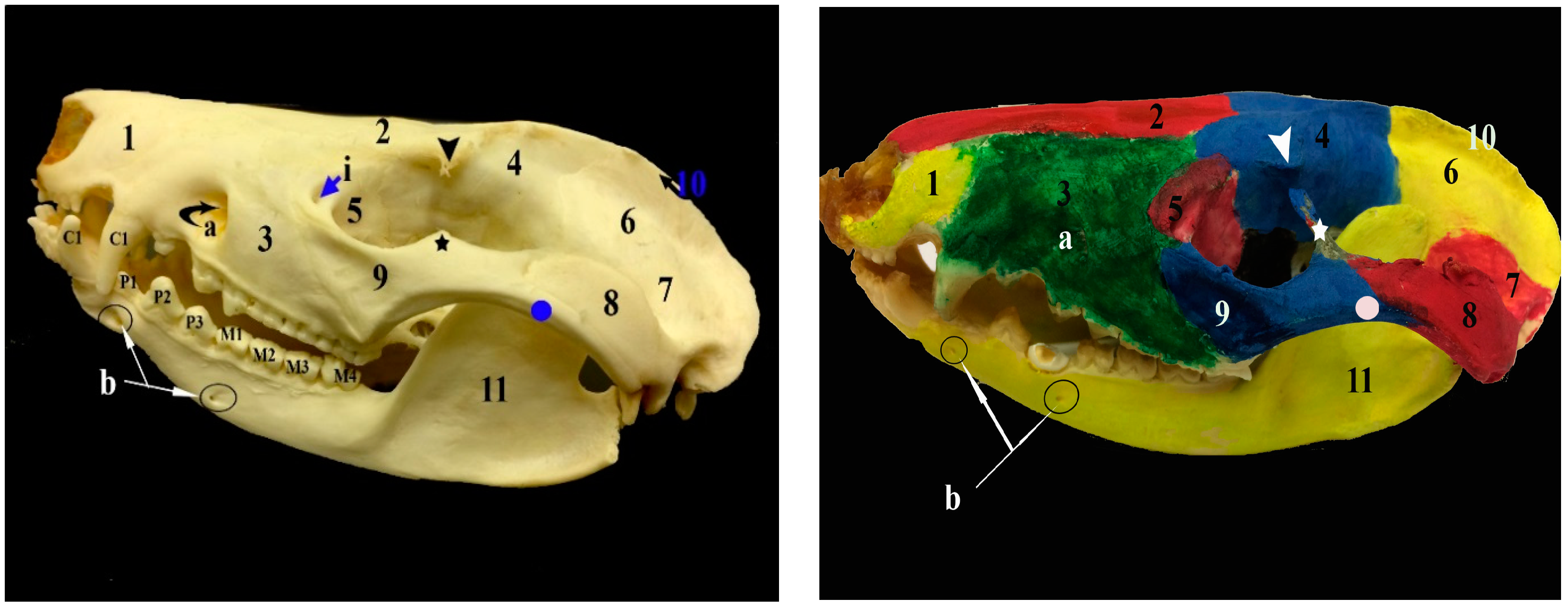
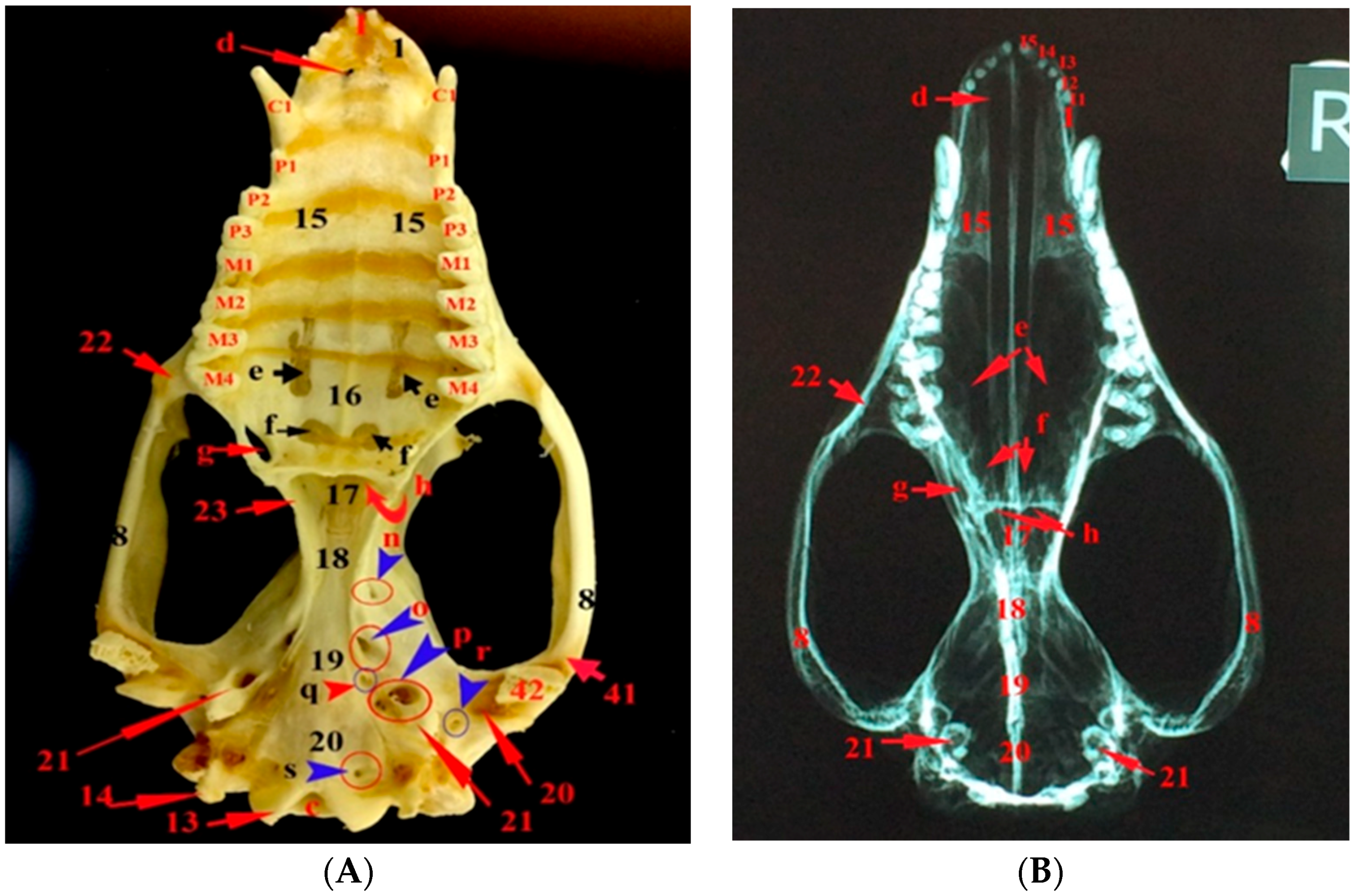
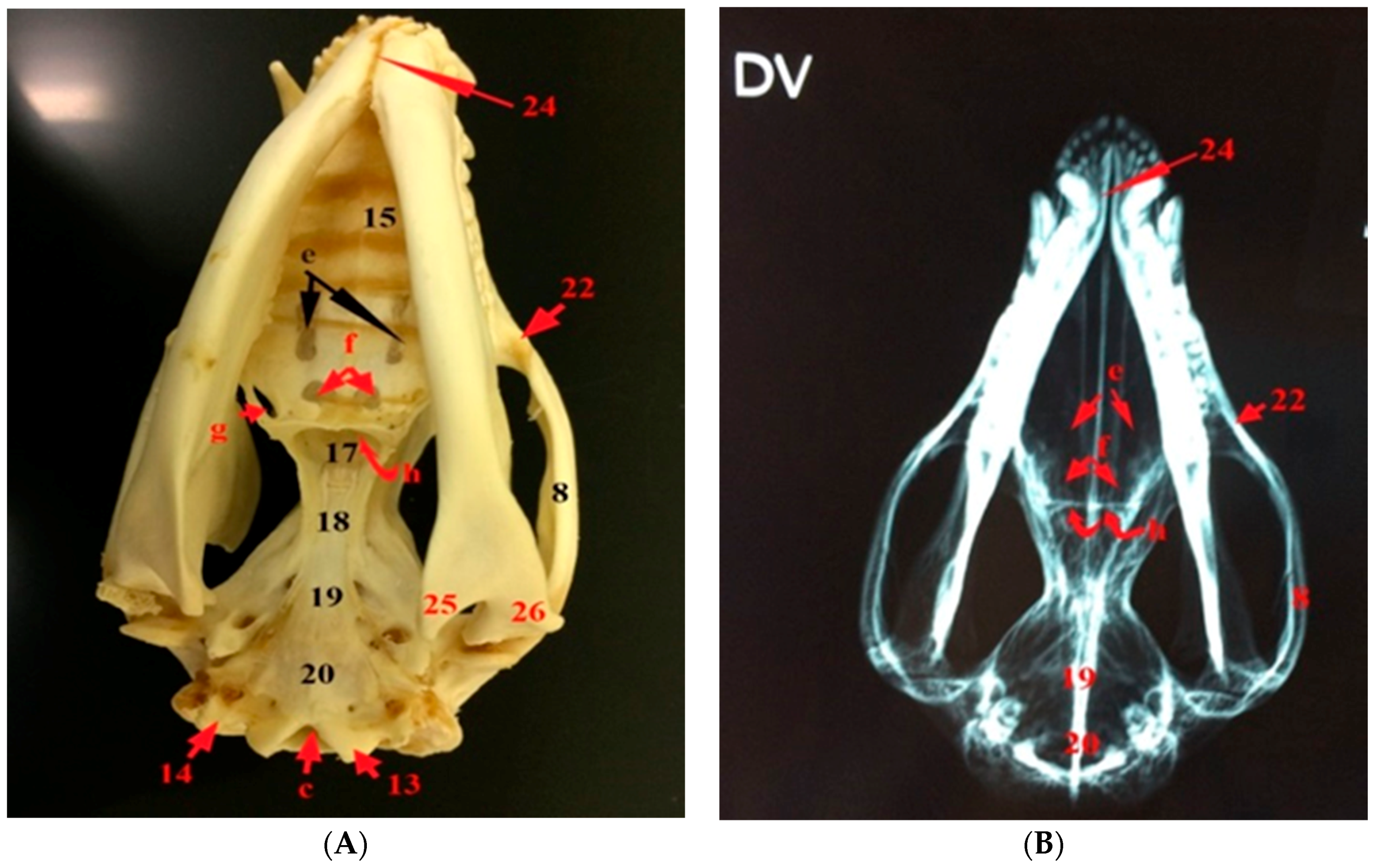
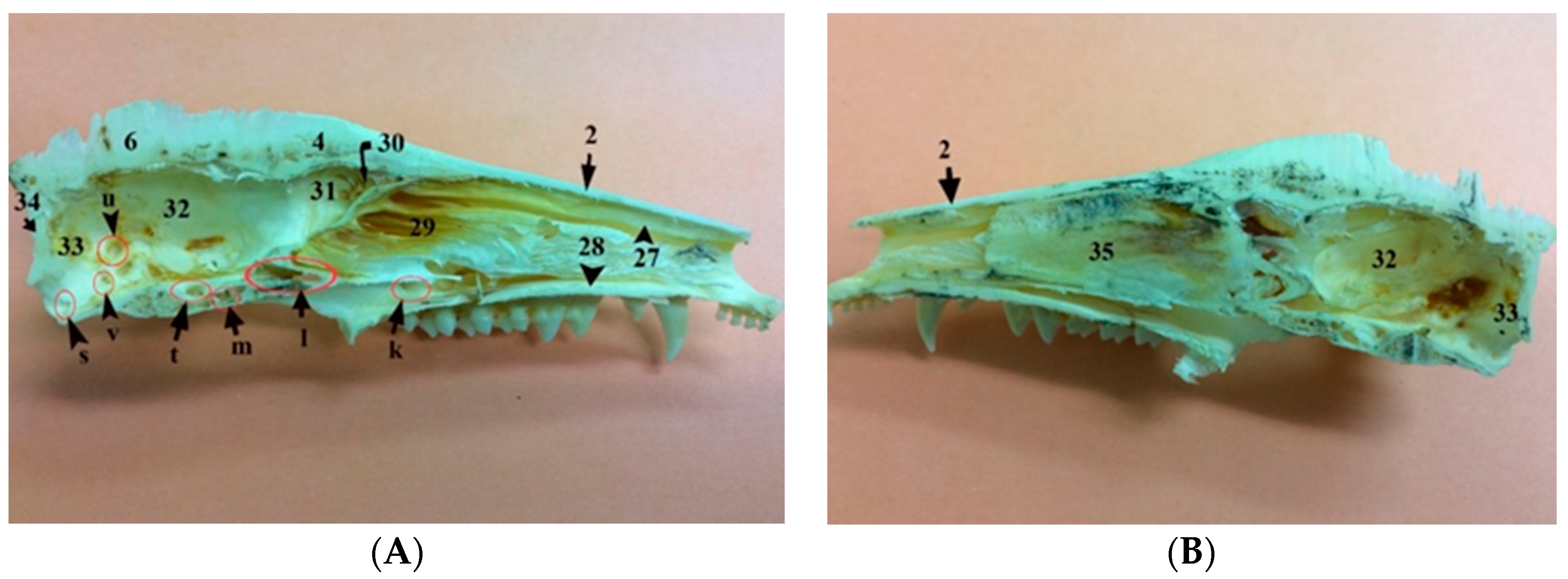
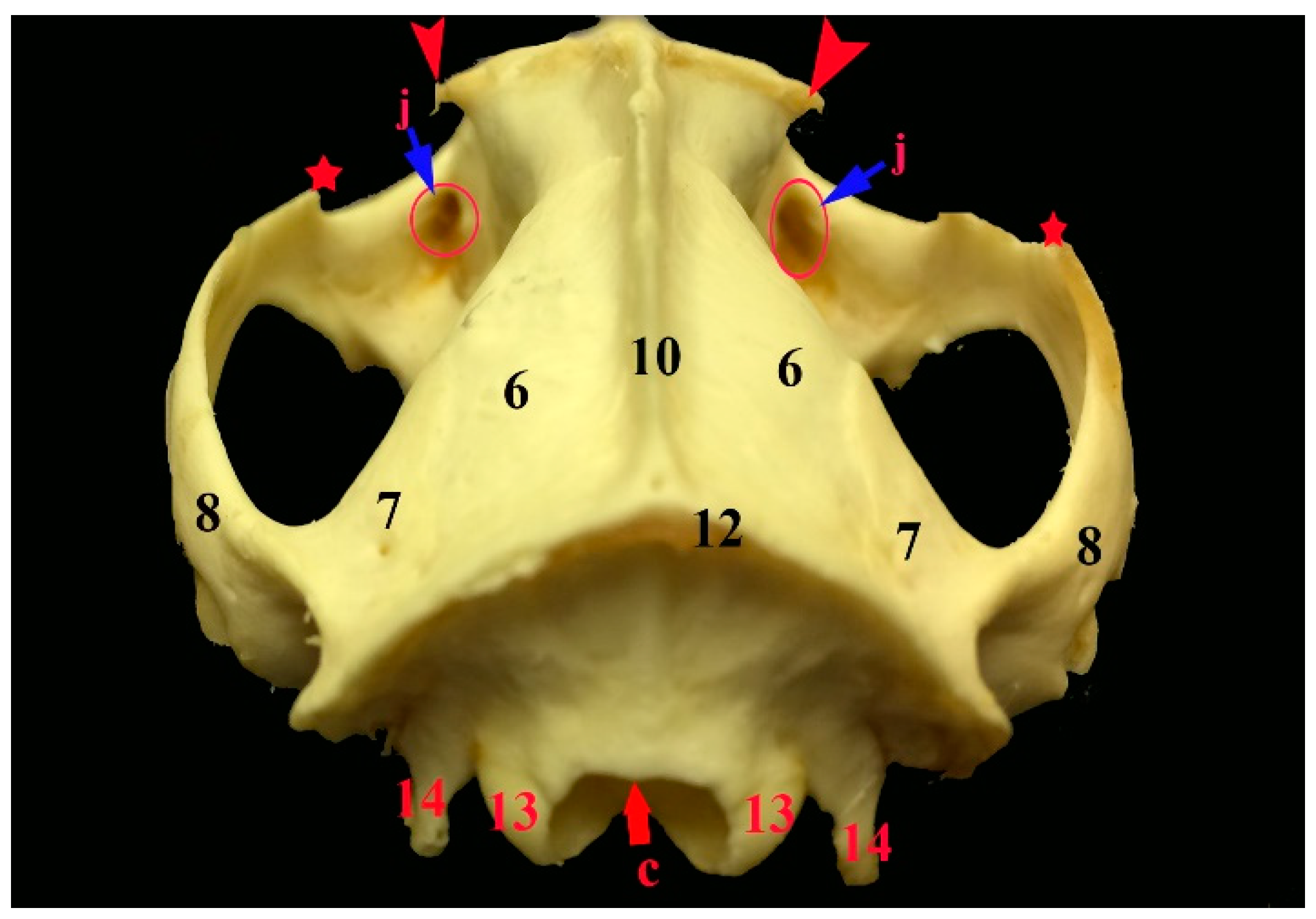
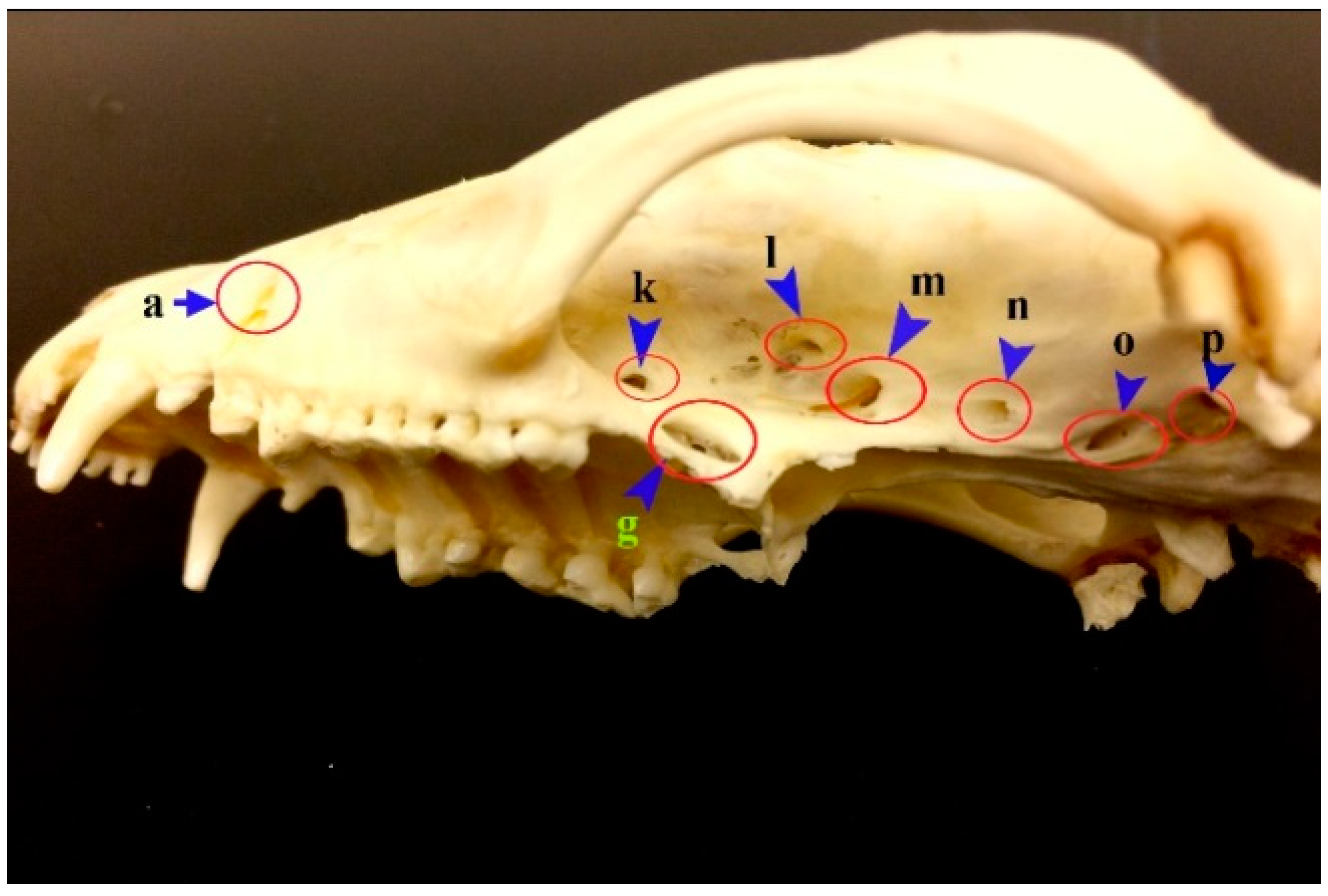
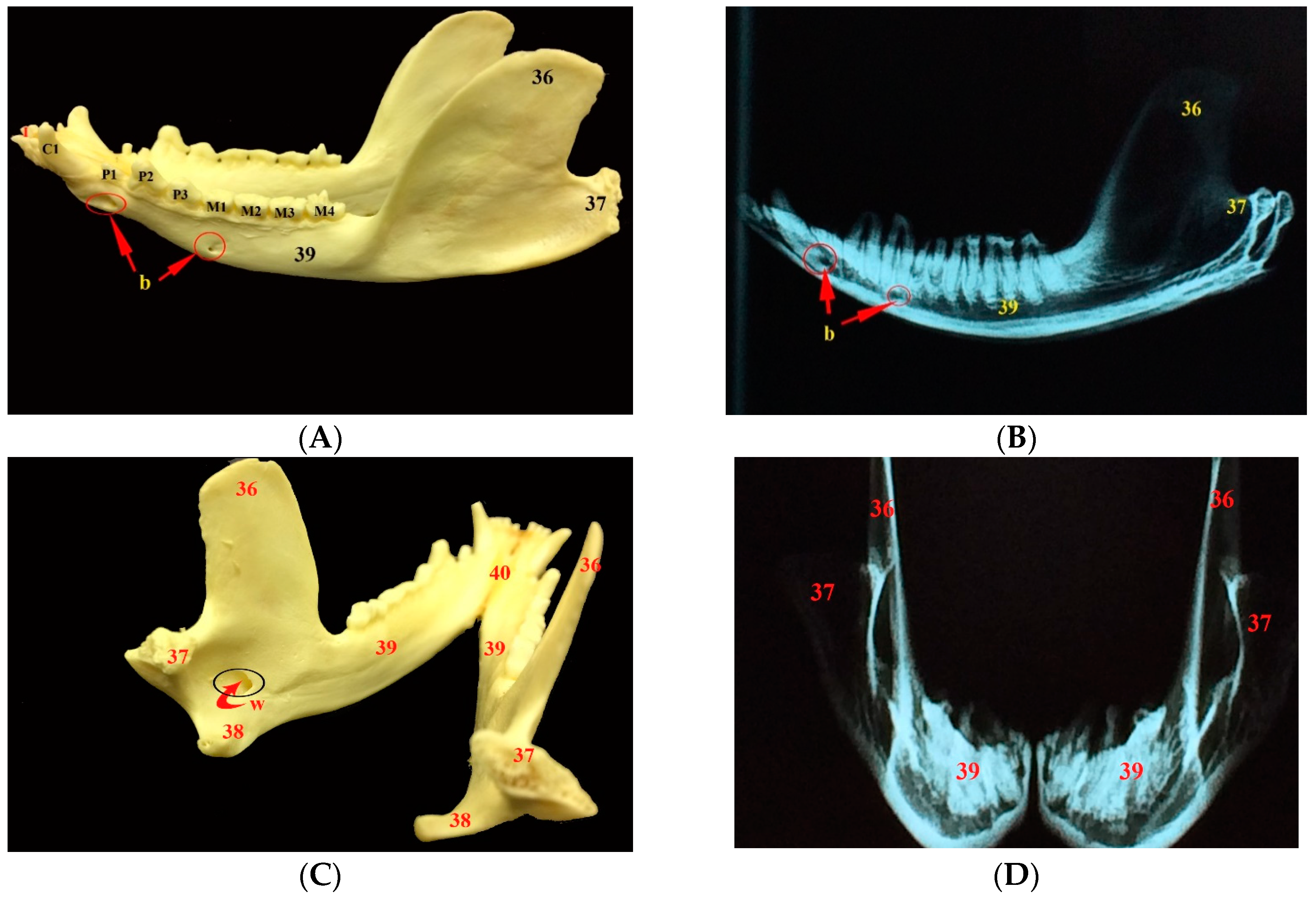

© 2018 by the author. Licensee MDPI, Basel, Switzerland. This article is an open access article distributed under the terms and conditions of the Creative Commons Attribution (CC BY) license (http://creativecommons.org/licenses/by/4.0/).
Share and Cite
Mohamed, R. Anatomical and Radiographic Study on the Skull and Mandible of the Common Opossum (Didelphis Marsupialis Linnaeus, 1758) in the Caribbean. Vet. Sci. 2018, 5, 44. https://doi.org/10.3390/vetsci5020044
Mohamed R. Anatomical and Radiographic Study on the Skull and Mandible of the Common Opossum (Didelphis Marsupialis Linnaeus, 1758) in the Caribbean. Veterinary Sciences. 2018; 5(2):44. https://doi.org/10.3390/vetsci5020044
Chicago/Turabian StyleMohamed, Reda. 2018. "Anatomical and Radiographic Study on the Skull and Mandible of the Common Opossum (Didelphis Marsupialis Linnaeus, 1758) in the Caribbean" Veterinary Sciences 5, no. 2: 44. https://doi.org/10.3390/vetsci5020044




